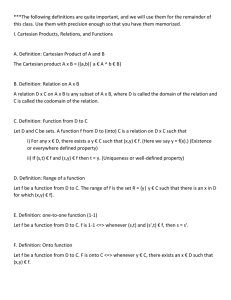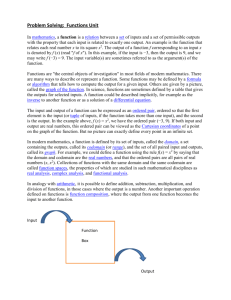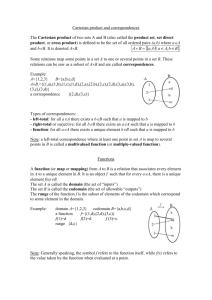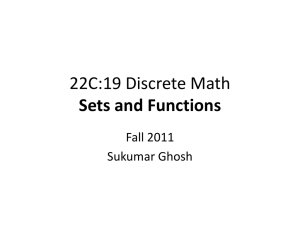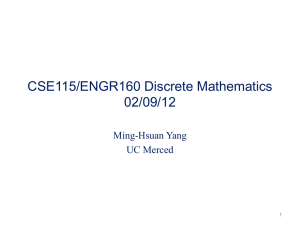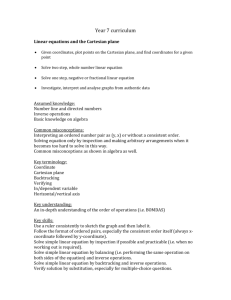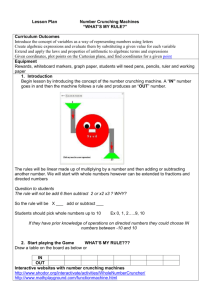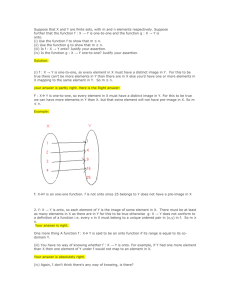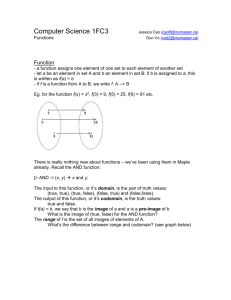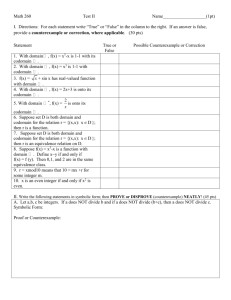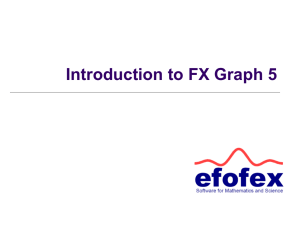lesson note - e-CTLT
advertisement
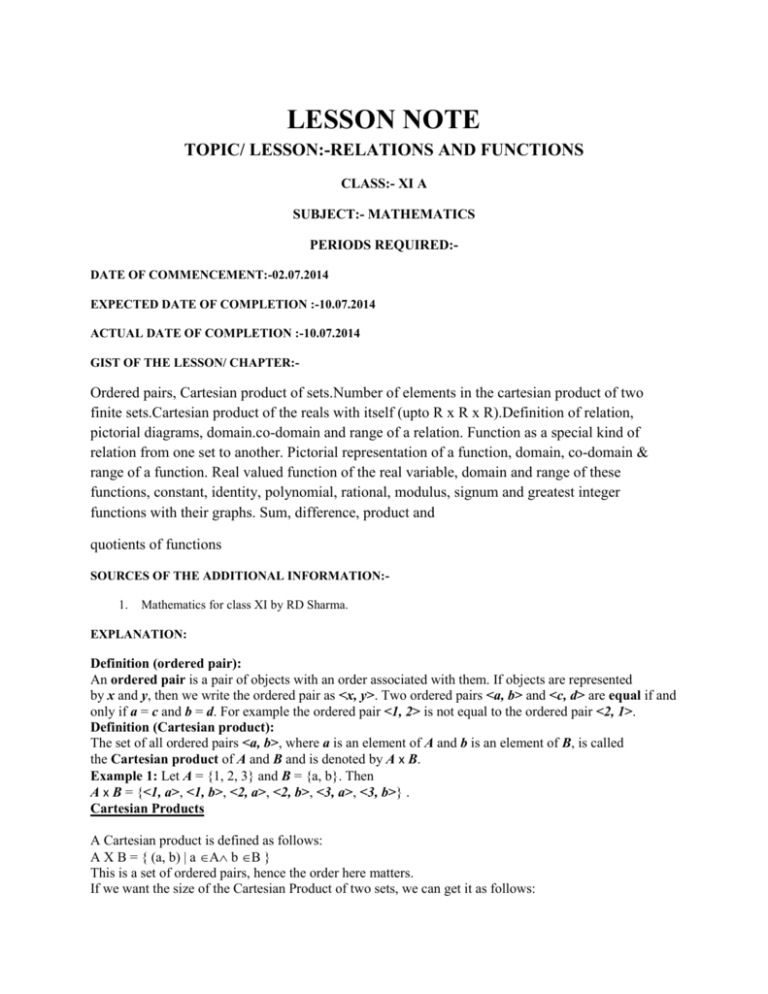
LESSON NOTE
TOPIC/ LESSON:-RELATIONS AND FUNCTIONS
CLASS:- XI A
SUBJECT:- MATHEMATICS
PERIODS REQUIRED:DATE OF COMMENCEMENT:-02.07.2014
EXPECTED DATE OF COMPLETION :-10.07.2014
ACTUAL DATE OF COMPLETION :-10.07.2014
GIST OF THE LESSON/ CHAPTER:-
Ordered pairs, Cartesian product of sets.Number of elements in the cartesian product of two
finite sets.Cartesian product of the reals with itself (upto R x R x R).Definition of relation,
pictorial diagrams, domain.co-domain and range of a relation. Function as a special kind of
relation from one set to another. Pictorial representation of a function, domain, co-domain &
range of a function. Real valued function of the real variable, domain and range of these
functions, constant, identity, polynomial, rational, modulus, signum and greatest integer
functions with their graphs. Sum, difference, product and
quotients of functions
SOURCES OF THE ADDITIONAL INFORMATION:1.
Mathematics for class XI by RD Sharma.
EXPLANATION:
Definition (ordered pair):
An ordered pair is a pair of objects with an order associated with them. If objects are represented
by x and y, then we write the ordered pair as <x, y>. Two ordered pairs <a, b> and <c, d> are equal if and
only if a = c and b = d. For example the ordered pair <1, 2> is not equal to the ordered pair <2, 1>.
Definition (Cartesian product):
The set of all ordered pairs <a, b>, where a is an element of A and b is an element of B, is called
the Cartesian product of A and B and is denoted by A x B.
Example 1: Let A = {1, 2, 3} and B = {a, b}. Then
A x B = {<1, a>, <1, b>, <2, a>, <2, b>, <3, a>, <3, b>} .
Cartesian Products
A Cartesian product is defined as follows:
A X B = { (a, b) | a A b B }
This is a set of ordered pairs, hence the order here matters.
If we want the size of the Cartesian Product of two sets, we can get it as follows:
|A X B| = |A| x |B|.
One way to see that this is the case is to list out all the elements in a Cartesian product in a table. Label all
the rows with elements from the set A, and all the columns with the elements from the set B. Each cell in
this table will contain an unique element of the Cartesian product of A and B. Furthermore, each element
of the Cartesian product can be found on the table. Thus, the total number of elements in the Cartesian
product is the total number of cells in the table, |A| x |B|.
Here is a problem involving Cartesian products:
If A C and B D, then A x B C x D.
We must show that if (x, y) A x B, then (x, y) C x D.
Consider an element (x, y) A x B.
By definition of a Cartesian product, we must have that xA and yB.
Using our given subset information, we can deduce that xC and yD.
Finally, considering the definition of a Cartesian product, we have that (x, y) C x D, as desired.
Relations
A binary relation R consists of three components: a domain A, a codomain B, and a subset of A B
called the “rule” for the relation.
Example: Let A = Z and B = N and let the rule be (x, y) R if y = x2
Inverse relations
Given a relation R with domain A and codomain B, the relation R-1 with domain B and codomain A is
called the inverse of R and is defined so that (x, y) R iff (y, x) R-1.
if R = {(1, 1), (1, 3), (2, 1), (2, 4)}
then R-1 = {(1,1), (3,1), (2,1), (4,2)}.
Domain, Co-domain and Range:
In its simplest form the domain is all the
values that go into a function, and the range is
all the values that come out.
But in fact they are very important
in defining a function. Read on!
There are special name for what can go into, and what can come out of a function:
What can go into a function is called the Domain.
What may possibly come out of a function is called the Codomain.
What actually comes out of a function is called the Range.
Codomain vs Range
The Codomain and Range are both on the output side, but are subtly different.
The Codomain is the set of values that could possibly come out. The Codomain is actually part of the
definition of the function.
And The Range is the set of values that actually do come out.
Example: you can define a function f(x)=2x with a domain and codomain of integers (because you say
so).
But by thinking about it you can see that the range (actual output values) would be just the even integers.
So the codomain is integers (you defined it that way), but the range is even integers.
The Range is a subset of the Codomain.
Functions
A function is a special type of relation. In particular, here are the rules for a relation to be a function, for
an arbitrary relation R A x B :
For each element in aA, we must have EXACTLY 1 element in R such that a is the first term of the
ordered pair. In English that means for each element in the set A it MUST BE related to exactly one
element in the set B. Typically, we call the set A the domain and the set B the co-domain. It is possible
that all of the possible values of f(a) (when a A) form only a proper subset of B. Thus the set of
possible values of the function, which can be more formally written as follows: f(A) = { f(a) | a A } is
known as the range of the function.
ADDITIONAL PROBLEMS:
1. Let f and g are functions on real numbers such that f(x) = x 3 – x 2 – x + 1
and g(x) = x2 – 1 . Find f + g , f – g , f . g and f / g .
2. Express A and R in Roaster Form if A={x : x is a natural number less than 15}and R be the
relation defined as R={(x,y):2x - y =1 where x , yA}. Find Domain, Co-domain and
Range of R .
3. If A=1,2,3,6, B=2,4,6, C=3,4,5,6.Verify A ( B C ) = ( A B ) ( A C ).
4. A={1,2} , B={1,2,3,4} , C={5,6} ,D={5,6,7,8} . Find (i)A( B C ) , (ii) B( D – C ).
5. A={x : x is a whole number less than 16}and relation R is defined as R={(x,y): 3x–y=0
where x , yA} .Write A and R in roster form, find domain , co-domain ,range of R .
6. Let f and g are two real valued functions such that f(x)= x3+ x2 – x–1 and g(x)=x2 –1 .
Find (i) f + g (ii) f – g (iii) ( f . g ) (0) (iv) f / g
.
7. Draw the graph of function : f(x) =
x2– 1
, x ≤ 1
– x2 – 1 , x > 1
.
8. Let R be the relation defined on set A to A where A=x : x Z and -5 x 5and
R=(x , y): x+2y=0 & x , y A. Find domain , Range and Co-domain of R .
9. Draw the graph of the function f(x)= 3 + x when x 0
3
when x = 0
3 – x when x 0 . Hence find the domain and range.
10. Let R be the relation defined on set B to R , where B=x : x Z and - 7 x 10
and R=(x , y) :x + 3y= 0. Find domain , Range and Co-domain of R .
HOME ASSIGNMENTS:
Exercises of NCERT Text Book: Ex 2.1, 2.2,Miscellaneous Exercise Chapter 2.
